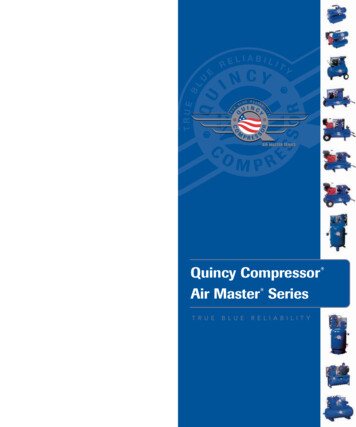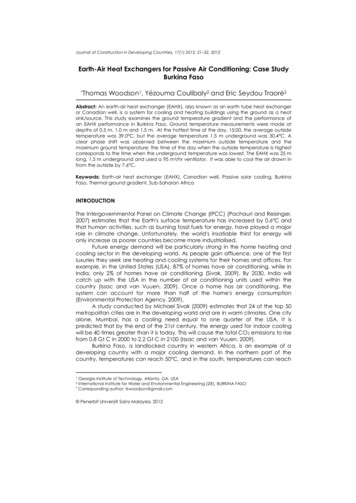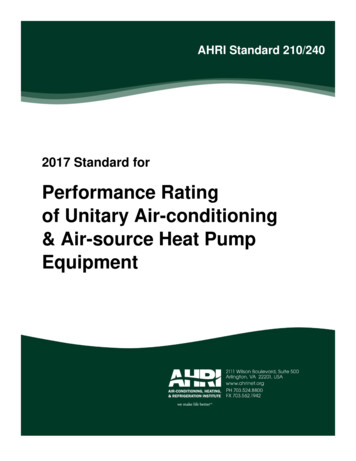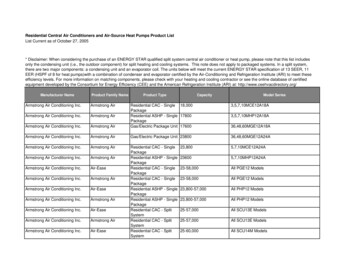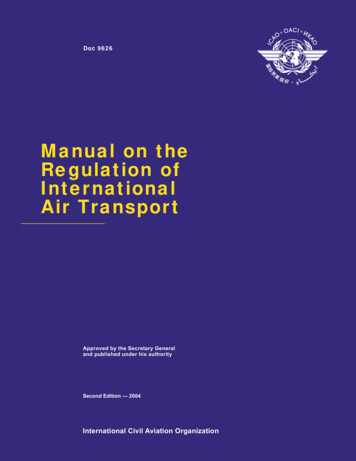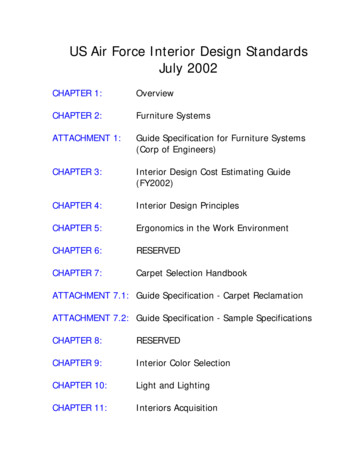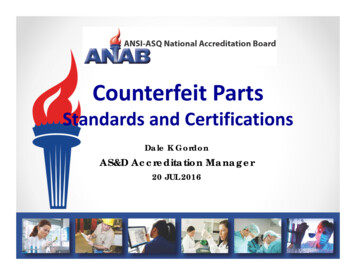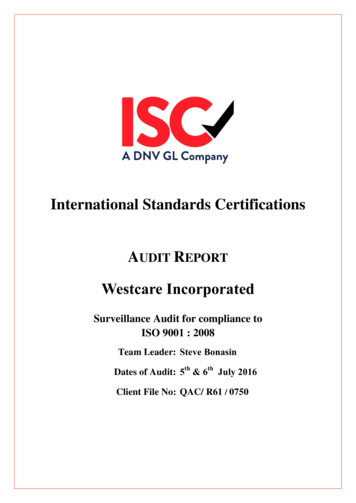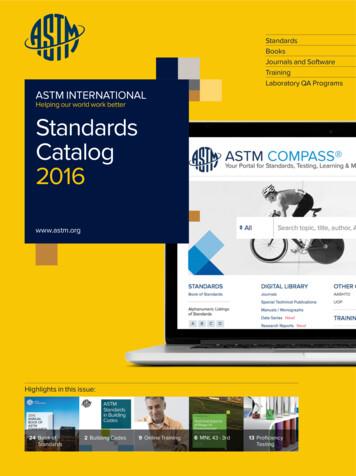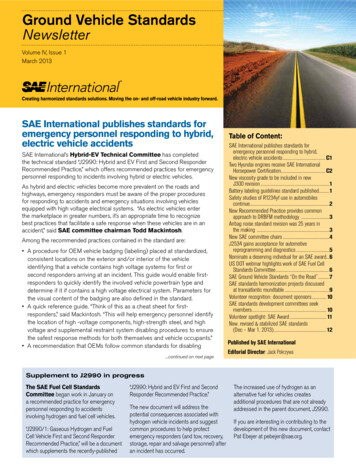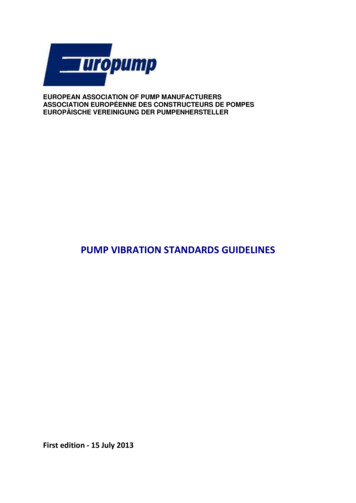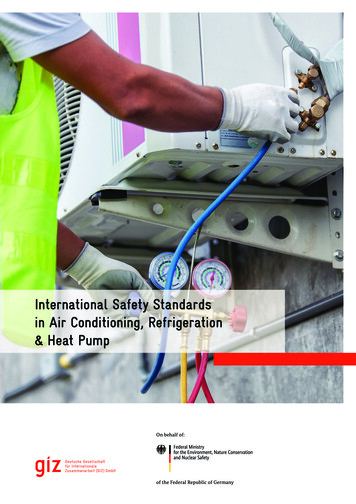
Transcription
International Safety Standardsin Air Conditioning, Refrigeration& Heat Pump
As a federally owned enterprise, GIZ supports the German Governmentin achieving its objectives in the field of international cooperation forsustainable development.Published by:Deutsche Gesellschaft fürInternationale Zusammenarbeit (GIZ) GmbHRegistered officesBonn and EschbornDag-Hammarskjöld-Weg 1-565760 Eschborn, GermanyT 49 61 96 79-1022F 49 61 96 79-80 1022E proklima@giz.deI www.giz.de/proklimaI www.green-cooling-initiative.orgProject:Project Green Cooling InitiativeResponsible:Nika Greger, GIZ GmbH, Project Manager Green Cooling InitiativeAuthor:Dr Daniel Colbourne (c/o HEAT GmbH)Peer Review:Dr Sukumar DevottaAcknowledgement for comments and supportPhilipp Denzinger, Joana Cortes Kollert, Nicole Mueller and Lena Bareiß (GIZ GmbH)Design/layout:cmuk, Iris Christmann, WiesbadenPhoto credits/sources:Cover: nikomsolftwaer / stock.adobe.com; Page 3: Rawpixel.com /Shutterstock.com; Page 5, 7: Andrii Zhezhera / Shutterstock.com;Page 10: Rawpixel.com / Shutterstock.com; Page 11: Olga Kashubin /shutterstock.com; Page 13: A stockphoto / shutterstock.com;Page 14: A stockphoto / shutterstock.com; Page 19: Nick Starichenko /Shutterstock.com; Page 21: nikomsolftwae – adobe.stock.com;Page 24: Nengloveyou / Shutterstock.com; Page 27: manine99 / Shutterstock.com;Page 28: Adisa / Shutterstock.com; Page 29: KeongDaGreat / Shutterstock.com;Page 36: Mehmet Cetin / Shutterstock.comURL links:This publication contains links to external websites. Responsibility for the contentof the listed external sites always lies with their respective publishers.When the links to these sites were first posted, GIZ checked the third-partycontent to establish whether it could give rise to civil or criminal liability.However, the constant review of the links to external sites cannot reasonably beexpected without concrete indication of a violation of rights. If GIZ itself becomesaware or is notified by a third party that an external site it has provided a link togives rise to civil or criminal liability, it will remove the link to this siteimmediately. GIZ expressly dissociates itself from such content.On behalf ofThe German Federal Ministry for the Environment, Nature Conservationand Nuclear SafetyDivision KI II 7 International Climate Finance, International Climate Initiative11055 Berlin, GermanyT 49 30 18 305-0F 49 30 18 305-43 75E KIII7@bmub.bund.deI www.bmub.bund.deGIZ is responsible for the content of this publication.Printing and distribution:Druckriegel, FrankfurtPrinted on 100% recycled paper, certified to FSC standards.Eschborn, June 2018
International Safety Standardsin Air Conditioning, Refrigeration & Heat Pump
02International Safety Standards in Air Conditioning, Refrigeration & Heat PumpkAbstractIn order to achieve the obligations of the Kigali Amendment under the Montreal Protocol, countriesmust adopt refrigerants with a lower Global warming potential (GWP). Natural refrigerants such ashydrocarbons, carbon dioxide and ammonia are suitable options, but present additional safetyhazards compared with conventional HCFC and HFC refrigerants, such that there is a heightenedneed to introduce appropriate safety standards. Current international safety standards for AirConditioning, Refrigeration and Heat Pump (ACR&HP) systems pose substantive barriers to theimplementation of natural refrigerants, by means of obstructive refrigerant charge size limits.A positive correlation between refrigerant quantity and cooling capacity is demonstrated for naturalrefrigerants, such that there is an explicit need to modify international safety standards to allowlarger charge sizes. In order to offset the increased flammability risk associated with a greaterallowable charge, additional safety measures to mitigate the risk can be introduced to ACR&HPsystems. These include improving leak tightness of the system, assuring sufficient airflow, adoptingequipment housing design and inclusion of valves.It is crucial that any changes to existing safety standards or requirements of entirely new safety standards should initially remain voluntary, as requirements are onerous by nature. After a trialperiod with a voluntary status, standards can subsequently be established as mandatory requirements. Based on experience over the past 20 years, it is estimated that it will take five to ten yearsfor new or revised standards to be published. Such timelines are inconsistent with the needs of theindustry to implement low GWP alternatives in time to comply with obligations under the MontrealProtocol and Kigali Amendment.This paper has been drafted under the Green Cooling Initiative (GCI), which is financed by the International Climate Initiative (IKI) of the German Federal Ministry of the Environment, Nature Conservation and Nuclear Safety (BMU).This paper intends to provide policy makers, standard authorities and private sector representativeswith an overview and orientation on international safety standards for ACR&HP systems, in particularaddressing developing countries that intend to widen the use of environmentally friendly refrigerants in a safe way. The document identifies what is currently feasible with existing safety standardrequirements, and what possibilities exist to ease the barriers and improve safety standards for thefuture. In particular, the following aspects are addressed:nnnnThe key safety standards applicable to ACR&HP systems;How those safety standards can be applied;Technical obligations arising from the various safety standards;Options and opportunities to improve safety standards internationally and/or nationally.
International Safety Standards in Air Conditioning, Refrigeration & Heat PumpkAbbreviationsACR&HPAir Conditioning, Refrigeration and Heat PumpCENEuropean Committee for StandardisationCENELECEuropean Committee for Electrotechnical StandardizationGCIGreen Cooling InitiativeGIZDeutsche Gesellschaft für Internationale Zusammenarbeit (GIZ) GmbHGWPGlobal Warming sHFCHydrofluorocarbonsIECInternational Electrotechnical CommissionISOInternational Standardisation OrganisationLFLLower Flammability LimitUNEPUnited Nations Environment Programme03
04International Safety Standards in Air Conditioning, Refrigeration & Heat PumpkContentsAbstract . . . . . . . . . . . . . . . . . . . . . . . . . . . . . . . . . . . . . . . . . . . . . . . . . . . . . . . . . . . . . . . . . . . . . 021 Introduction. . . . . . . . . . . . . . . . . . . . . . . . . . . . . . . . . . . . . . . . . . . . . . . . . . . . . . . . . . . . . . . . . 052 Overview and choice of relevant ACR&HP safety standards. . . . . . . . . . . . . . . . . . . . . . . . . . . . . 073 Relationship between safety standards and national regulations. . . . . . . . . . . . . . . . . . . . . . . . 114 Current requirements for systems using flammable refrigerants. . . . . . . . . . . . . . . . . . . . . . . . . 145 Recommendation on amended safety standards for natural refrigerants,specifically hydrocarbon refrigerants. . . . . . . . . . . . . . . . . . . . . . . . . . . . . . . . . . . . . . . . . . . . . . 196 Advancing national and international safety standards . . . . . . . . . . . . . . . . . . . . . . . . . . . . . . . . 247 References. . . . . . . . . . . . . . . . . . . . . . . . . . . . . . . . . . . . . . . . . . . . . . . . . . . . . . . . . . . . . . . . . . 29.kList of TablesTable 1: Scope of different international and regional safety standards for ACR&HP systems . . . . 08Table 2: General technical obligations under safety standards for ACR&HP systems. . . . . . . . . . . 15Table 3: Refrigerant charge size limits according to safety standards for ACR&HP systems . . . . . 16Table 4: Approximate capacity range of different types of applications using HC,R744 and R717. . . . . . . . . . . . . . . . . . . . . . . . . . . . . . . . . . . . . . . . . . . . . . . . . . . . . . . . . 18Table 5: Options for resolving obstructive safety standards. . . . . . . . . . . . . . . . . . . . . . . . . . . . . . 26.kList of FiguresFigure 1: Example relationship between refrigerant charge and cooling capacity as afunction of seasonal efficiency of an air conditioner (SEER) with R290 . . . . . . . . . . . . . . 09Figure 2: Example relationship between room size and refrigerant charge limits. . . . . . . . . . . . . . 17Figure 3: Comparison of different alternative charge size methods and those incurrent standards for an R290 (propane) system in different room sizes. . . . . . . . . . . . . 23Figure 4: Flow chart identifying the main decisions and stepsfor addressing national safety standards . . . . . . . . . . . . . . . . . . . . . . . . . . . . . . . . . . . . . 27
kINTRODUCTION1
06International Safety Standards in Air Conditioning, Refrigeration & Heat Pump1. IntroductionThere is a significant trend towards applying natural refrigerants as low global warming potential(GWP) alternatives to ozone depleting substances (ODSs) and conventional higher GWP hydrofluorocarbons (HFCs). Since the adoption of the Kigali Amendment of the Montreal Protocol on the phasedown of HFCs on 15th October, 2016, several countries have already ratified it. The Amendment isexpected to enter into force on 1st January 2019.Low GWP alternative refrigerants include both synthetic and natural refrigerants. The syntheticalternatives typically include certain saturated HFCs, unsaturated HFCs and unsaturated hydrochlorofluorocarbons (HCFCs) and mixtures thereof; whilst these have some attractive characteristics,many exhibit relatively poor thermo-physical properties thus inferring greater investment required toachieve certain system efficiency. Moreover, most unsaturated HFCs and HCFCs have fairly low saturated vapour pressures and therefore require larger system components in order to match coolingor heating capacity of many of the existing refrigerants – the comparatively high cost of theseunsaturated fluorocarbons is therefore exaggerated due to greater material costs and acorresponding larger refrigerant charge. These problems can be overcome to a certain extent bymixing with existing HFCs, but in many cases it results in refrigerant blends with undesirably highGWP and/or temperature glide.Natural refrigerants, including hydrocarbons (HCs), carbon dioxide (R744), and ammonia (R717) haveexcellent thermo-physical properties compared to fluorinated refrigerants, corresponding to highpotential system efficiency as well as being relatively cheap. On the other hand, HCs, R744 and R717present additional safety hazards compared with conventional HCFC and HFC refrigerants. As such,there is a heightened need to employ safety standards. However, it is recognised that the currentinternational safety standards for refrigeration, air conditioning and heat pump (ACR&HP) applicationspose some constraints, mostly in terms of limits on the quantity of refrigerant permitted in systems.Safety standards have a particular relevance with regard to use and use restrictions for refrigerantsin ACR&HP systems. This was identified as one of the main obstacles to the uptake of environmentallyfriendly refrigerants in a United Nations Environment Programme (UNEP) study on barriers for lowGWP alternatives in Article 5 countries (Colbourne, 2010), although equally applies to non-Article 5too. Reasons for these limitations are largely due to historical dominance of non-flammable, lowertoxicity refrigerants, the inertia associated with changing safety standards (and the views of stakeholders), and also the interests of stakeholders with commercial interests in competing technologies.This document is intended to introduce the topic of international safety standards for ACR&HPsystems, in particular addressing developing countries that intend to widen the use of environmentally friendly refrigerants in a safe way. It identifies what is currently feasible with existing safetystandard requirements, and which possibilities exist to ease the barriers and improve safetystandards for the future. In particular, the following aspects are addressed:nnnnThe key safety standards applicable to ACR&HP systems;How those safety standards can be applied;Technical obligations arising from the various safety standards;Options and opportunities to improve safety standards internationally and/or nationally.
2k OVERVIEW AND CHOICE OF RELEVANTACR&HP SAFETY STANDARDS
08International Safety Standards in Air Conditioning, Refrigeration & Heat Pump2. Overview and choice of relevant ACR&HPsafety standardsWithin the context of the ACR&HP sector, there are two international standardisation organisationsthat publish relevant safety standards: the International Standardisation Organisation (ISO) and theInternational Electrotechnical Commission (IEC). Similarly, at European (regional) level there areequivalent organisations – the European Committee for Standardisation (CEN) and the EuropeanCommittee for Electrotechnical Standardization (CENELEC) – which publish comparable standardsthat broadly cover the same scope and requirements to those of ISO and IEC.1Table 1 provides a summary of the key international and regional standards and their scope. Thoselisted are categorised as “vertical” or product standards and as “horizontal” or group standards.Broadly speaking, vertical standards take precedence over horizontal standards, as they are intendedto be developed specifically for particular product types and thus have requirements that are morerefined for particular cases. Thus, horizontal standards are assumed to cover everything that is nothandled by the vertical standards. That is, they include more generic and overarching requirementsbased on common characteristics and practices of any ACR&HP equipment, installations andtechnician activities.However, the boundaries between vertical and horizontal standards are not rigid and ul
International Safety Standards in Air Conditioning, Refrigeration & Heat Pump 03 kAbbreviations ACR&HP Air Conditioning, Refrigeration and Heat Pump CEN European Committee for Standardisation CENELEC European Committee for Electrotechnical Standardization GCI Green Cooling Initiative GIZ Deutsche Gesellschaft für Internationale Zusammenarbeit (GIZ) GmbH
